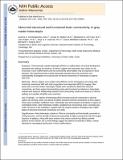| dc.contributor.author | Christodoulou, Joanna | |
| dc.contributor.author | Walker, Linsey M. | |
| dc.contributor.author | Del Tufo, Stephanie N. | |
| dc.contributor.author | Katzir, Tami | |
| dc.contributor.author | Gabrieli, John D. E. | |
| dc.contributor.author | Gabrieli, Susan | |
| dc.contributor.author | Chang, Bernard S. | |
| dc.date.accessioned | 2014-07-24T13:26:32Z | |
| dc.date.available | 2014-07-24T13:26:32Z | |
| dc.date.issued | 2012-06 | |
| dc.identifier.issn | 00139580 | |
| dc.identifier.uri | http://hdl.handle.net/1721.1/88478 | |
| dc.description | available in PMC 2013 June 01 | en_US |
| dc.description.abstract | Purpose: Periventricular nodular heterotopia (PNH) is a malformation of cortical development associated with epilepsy and dyslexia. Evidence suggests that heterotopic gray matter can be functional in brain malformations and that connectivity abnormalities may be important in these disorders. We hypothesized that nodular heterotopia develop abnormal connections and systematically investigated the structural and functional connectivity of heterotopia in patients with PNH.
Methods: Eleven patients were studied using diffusion tensor tractography and resting-state functional connectivity MRI with bold oxygenation level–dependent (BOLD) imaging. Fiber tracks with a terminus within heterotopic nodules were visualized to determine structural connectivity, and brain regions demonstrating resting-state functional correlations to heterotopic nodules were analyzed. Relationships between these connectivity results and measures of clinical epilepsy and cognitive disability were examined.
Key Findings: A majority of heterotopia (69%) showed structural connectivity to discrete regions of overlying cortex, and almost all (96%) showed functional connectivity to these regions (mean peak correlation coefficient 0.61). Heterotopia also demonstrated connectivity to regions of contralateral cortex, other heterotopic nodules, ipsilateral but nonoverlying cortex, and deep gray matter structures or the cerebellum. Patients with the longest durations of epilepsy had a higher degree of abnormal functional connectivity (p = 0.036).
Significance: Most heterotopic nodules in PNH are structurally and functionally connected to overlying cortex, and the strength of abnormal connectivity is higher among patients with the longest duration of epilepsy. Along with prior evidence that cortico-cortical tract defects underlie dyslexia in this disorder, the current findings suggest that altered connectivity is likely a critical substrate for neurologic dysfunction in brain malformations. | en_US |
| dc.description.sponsorship | National Institutes of Health (U.S.) (NIH/NINDS R01 NS073601) | en_US |
| dc.description.sponsorship | National Institutes of Health (U.S.) (NIH/NINDS K23 NS049159) | en_US |
| dc.description.sponsorship | Epilepsy Foundation of America | en_US |
| dc.description.sponsorship | Harvard University (William F. Milton Fund) | en_US |
| dc.language.iso | en_US | |
| dc.publisher | John Wiley & Sons, Inc | en_US |
| dc.relation.isversionof | http://dx.doi.org/10.1111/j.1528-1167.2012.03466.x | en_US |
| dc.rights | Creative Commons Attribution-Noncommercial-Share Alike | en_US |
| dc.rights.uri | http://creativecommons.org/licenses/by-nc-sa/4.0/ | en_US |
| dc.source | PMC | en_US |
| dc.title | Abnormal structural and functional brain connectivity in gray matter heterotopia | en_US |
| dc.type | Article | en_US |
| dc.identifier.citation | Christodoulou, Joanna A., Linsey M. Walker, Stephanie N. Del Tufo, Tami Katzir, John D. E. Gabrieli, Susan Whitfield-Gabrieli, and Bernard S. Chang. “Abnormal Structural and Functional Brain Connectivity in Gray Matter Heterotopia.” Epilepsia 53, no. 6 (June 2012): 1024–1032. | en_US |
| dc.contributor.department | Massachusetts Institute of Technology. Department of Brain and Cognitive Sciences | en_US |
| dc.contributor.department | McGovern Institute for Brain Research at MIT | en_US |
| dc.contributor.mitauthor | Christodoulou, Joanna | en_US |
| dc.contributor.mitauthor | Del Tufo, Stephanie N. | en_US |
| dc.contributor.mitauthor | Gabrieli, John D. E. | en_US |
| dc.contributor.mitauthor | Gabrieli, Susan | en_US |
| dc.relation.journal | Epilepsia | en_US |
| dc.eprint.version | Author's final manuscript | en_US |
| dc.type.uri | http://purl.org/eprint/type/JournalArticle | en_US |
| eprint.status | http://purl.org/eprint/status/PeerReviewed | en_US |
| dspace.orderedauthors | Christodoulou, Joanna A.; Walker, Linsey M.; Del Tufo, Stephanie N.; Katzir, Tami; Gabrieli, John D. E.; Whitfield-Gabrieli, Susan; Chang, Bernard S. | en_US |
| dc.identifier.orcid | https://orcid.org/0000-0002-8304-4791 | |
| dc.identifier.orcid | https://orcid.org/0000-0003-1158-5692 | |
| mit.license | OPEN_ACCESS_POLICY | en_US |
| mit.metadata.status | Complete | |
